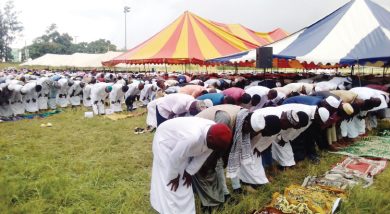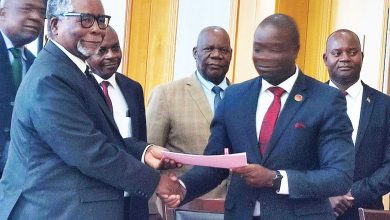Dressed by foreigners

How did Malawi turn from a nation that could manufacture its own clothing to one that is fully dependent on foreign manufacturers? Our news analyst EPHRAIM NYONDO begins to explore.
If you are male, of the shirts in your wardrobe, how many carry the label ‘Made in Malawi?’ The same can be asked to females: of the dresses or blouses you have, how many have the ‘Made in Malawi’ label?
Most Malawians will agree that they have very few, if any, clothes that are made locally. The situation extends to beddings, curtains, tablecloths and many other materials used in the household.
If the item is not from East Asia—China, Singapore or Malaysia—then it is made in the US, Europe or even South Africa.
Clearly, when it comes to clothing, Malawians today are dressed by foreigners.
But things were not like this in the 1980s, specifically in 1985 when Jamison Phiri, 72, started tailoring outside a bottle store in Blantyre City.
“I learnt tailoring from my father. I bought my tailoring machine and moved into the city from my home village in Balaka. Tailoring was big business.
“You had a number of orders; men’s and women’s suits, shirts, skirts, trousers, school uniforms, church clothing and many other things,” says Phiri.
He says he would buy cloth from David Whitehead and Sons Limited, design clothes, tailor them and put them on display.
“It did not take long for them to be bought,” he says.
Phiri adds that the golden years of tailoring even spilled into the early to mid 1990s.
“I would receive many orders, especially from women. With weddings and engagement ceremonies, you had a lot of people seeking our services. It was big business,” he says.
And the business created great fortunes for his family. Married with four children—all of them educated to college level—Phiri, who has never been employed, says he built four houses in Ndirande, Blantyre, from tailoring. That was by 1999.
The fortunes Phiri made out of tailoring before 1999, symbolise Malawi’s golden years of textile and clothing industry.
Veteran politician Sam Mpasu—a Chancellor College graduate of economics who served as industrial licensing officer in the Ministry of Commerce, Trade and Tourism between 1970 and 1973, and served as Minister of Trade and Commerce from 2002 to 2003—argues that in terms of textile and cloth production, Malawi has not been that vibrant since the 1950s.
“One striking characteristic of this industry is that it is not integrated. The bulk of the cotton that is produced is exported in semi-processed form and the garments manufacturers use imported raw materials,” he says.
However, Mpasu underlines that from the 1970’s to the late 1990s—especially 1995; Malawi fared relatively well compared to neighbouring countries in its textile and clothing industries.
“The underlying factor was that a number of Malawians, then, were dressing in clothes that were made within the country. We had a number of garment industries that were making nice clothes. Domestically, they were well supported,” says Mpasu, who adds that it was rare in his college days to see a student donning an imported suit.
The relatively good things stemming from Malawi’s textile and clothing industry as portrayed by Banda and Mpasu did not come by default. They were a product of the then government’s industrial policy.
After attaining independence, like many other African countries, Malawi—according to a 2006 article titled The African Textile and Clothing Industry: From Import Substitution to Export Orientation by researcher Herbert Jauch—pursued import substitution industrial policy as a way of protecting its infant manufacturing sector.
Jauch argues that import substitution (IS) is based on the principle that the State plays a key developmental role and an active State policy is the main tool to transform an agrarian economy into an industrial society.
“IS is a strategy to target the domestic market. Companies set up through national (private or public) or foreign investments were provided with a local market and protected from outside competition through customs duties, through quantity restrictions on imports or by out-rightly banning them,” he writes.
This saw the establishment of the David Whitehead and Sons—the country’s main textile and clothing industry which, according to James Chimbiya, an employee who joined it in 1986, employed thousands.
The heart of its relative success, continues Jauch, was that the first two of the so-called development decades (1960s and 1970s) of the import substitution were at a time when the World Trade Organisation (WTO) was not yet in existence, when no Most Favoured Nation (MFN) clause made discrimination policies difficult and when no binding of tariffs or prohibition on quantity restrictions narrowed the policy space of national governments.
“This was the time, when import substitution was even the favoured development approach by the World Bank, when foreign debt was not yet an issue and the IMF had no say in the macro-economic policies of African states,” he writes.
However, according to Mpasu, the IS began to phase out by the 80s due to two price shocks in the early 1970s which saw the price of a barrel of crude oil first jumped from $2 (1972) to $12 (1974) and later on from $17 (1978) to $40 (1980/81).
“Government was forced to finance their fuel imports with foreign loans, for political reasons mostly not daring to increase the price of local fuel accordingly,” he says.
As a result, the World Bank called on government to obtain more foreign loans, without giving much consideration to their future capacity to service debts.
But when the foreign debts exploded in the 1980s, argues Mpasu, import substitution came to a virtual standstill and was rolled back by the infamous Structural Adjustment Programmes (SAPs).
“The developmental role of the state, as a result, was curtailed under the new World Bank/IMF dogma of ‘leaving development to the market forces.”
“Government subsidies to the manufacturing sector were cut, restrictions on foreign trade removed and currencies depreciated. Domestic manufacturers suddenly had to openly compete with importers and, in most cases, lost large parts of domestic markets,” he says.
DWS, as a result, wobbled and so did other players in the garment industry.
“Today, I spend days without having an order. We survive on school uniforms, sewing torn clothes and altering big ones. The glorious days are over. You just can’t make enough money from tailoring as we did in the past,” says Phiri.
Tomorrow: How is the textile industry doing? The case of Mapeto DWS.






Do you remember shirts like Robin Bridge etc that were locally manufactured? National wear where ladies would buy local beautiful cloth and have dresses made? We need to have strong policies where we need to ban importation of things we can locally make!! Kaunjika, china wear etc!!
Fashion designs change over time and it is important that there are fashion shows that highlight Malawian fashion and what and how we want it to evolve or fuse with other designs. I think the industry can be revamped if designers and manufacturers meet and find innovate ways of improving the quality and design of our cloths as well as look at the cost that can be made affordable to most Malawians. These will naturally kill off competition from Kaunjika.
Guys you have shown in picture are not the who can talk sense now. These two guys were under Muluzi Kingdom, they are the ones sold DWS to Mapeto to a tune of K50,000,000.00 This Guy Mpasu was the former cabinet minister who told us the same stories before he was in UDF government, a chance was given to him, he was there in Government for 10 solid years, nothing tangible, no development whatsoever, left the government in total shamble. Muluzi Gvt left the country while the rate was 34%, This mpasu and Chiwambo were there, they did all they could misusing and abuse the public office, they were given the best shot, but what did they gave us in return, garbage in the streets, mizikiti all along BT – LL road, all the lebanese and pakistanians turn to be born in Mangochi, Malawi. This is why Atupele is having it hard to convince people that he has his own agenda for change, he is suffering from the promises from heaven that said “NDIDZALANGA ANA CHIFUKWA CHA A ATATE AWO” almost every one wanted to speak yao, just like when everybody wanted to come from Kasungu and Dedza during Kamuzu. Bingu took over, the first % years he did well brought the interest rate down to 17% at least if not 7% at the least. he messed up the second term since he become stubborn. He also introduced Lomwe syndrome, everyone wanted to greet everybody like this, Moseliwa more ? unlike Amayi, who has put people in between, and they asking themselves should i speak yao, tumbuka, or chitonga ? since her hubby is a pure tonga ADA and her VP is a tumbuka. In such a way she is also confused, she does not know where to take people or when to visit countries and people. she is the most globe trotting president the world has ever had. Conratulations amayi. Her gvt is the bravest that protects Mahule, mahule amauzidwa to report when they are falsed into sex activities, we can’t say rapped since its their duty. when they rape other peoples husband or false them into sex activities Joyce Banda amati its okay. Kodi is it because she has gone through the same route ? Her government allows men to marry men and women to be marrying women ( Amayi akuloleza mathanyula) unlike the past leaders.
I just wanted to say Sam mpasu, Ziriro Chiwambo and the rest of UDF please do not lie to Malawians, you have no substance, you failed Malawians big time. Rest In Peace.